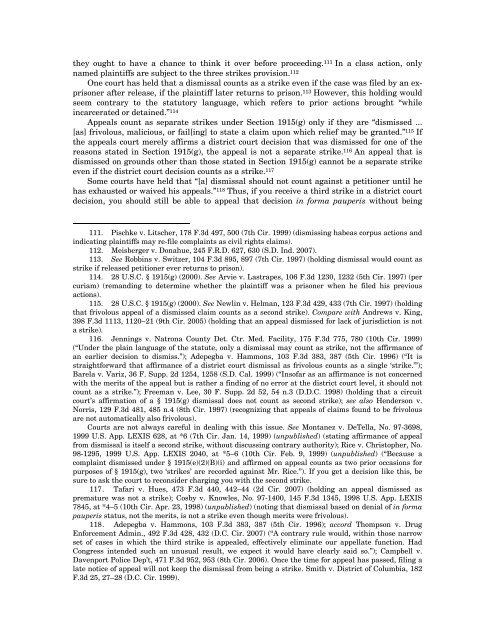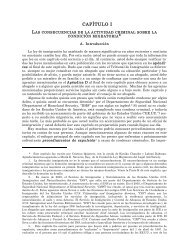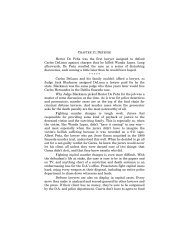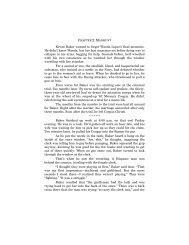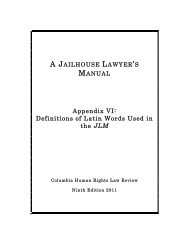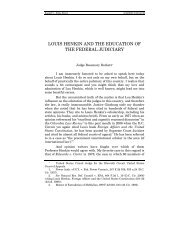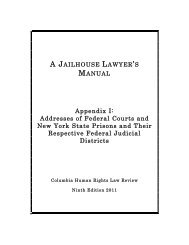A Jailhouse Lawyer's Manual Chapter 14 - Columbia Law School
A Jailhouse Lawyer's Manual Chapter 14 - Columbia Law School
A Jailhouse Lawyer's Manual Chapter 14 - Columbia Law School
Create successful ePaper yourself
Turn your PDF publications into a flip-book with our unique Google optimized e-Paper software.
they ought to have a chance to think it over before proceeding. 111 In a class action, only<br />
named plaintiffs are subject to the three strikes provision. 112<br />
One court has held that a dismissal counts as a strike even if the case was filed by an exprisoner<br />
after release, if the plaintiff later returns to prison. 113 However, this holding would<br />
seem contrary to the statutory language, which refers to prior actions brought “while<br />
incarcerated or detained.” 1<strong>14</strong><br />
Appeals count as separate strikes under Section 1915(g) only if they are “dismissed ...<br />
[as] frivolous, malicious, or fail[ing] to state a claim upon which relief may be granted.” 115 If<br />
the appeals court merely affirms a district court decision that was dismissed for one of the<br />
reasons stated in Section 1915(g), the appeal is not a separate strike. 116 An appeal that is<br />
dismissed on grounds other than those stated in Section 1915(g) cannot be a separate strike<br />
even if the district court decision counts as a strike. 117<br />
Some courts have held that “[a] dismissal should not count against a petitioner until he<br />
has exhausted or waived his appeals.” 118 Thus, if you receive a third strike in a district court<br />
decision, you should still be able to appeal that decision in forma pauperis without being<br />
111. Pischke v. Litscher, 178 F.3d 497, 500 (7th Cir. 1999) (dismissing habeas corpus actions and<br />
indicating plaintiffs may re-file complaints as civil rights claims).<br />
112. Meisberger v. Donahue, 245 F.R.D. 627, 630 (S.D. Ind. 2007).<br />
113. See Robbins v. Switzer, 104 F.3d 895, 897 (7th Cir. 1997) (holding dismissal would count as<br />
strike if released petitioner ever returns to prison).<br />
1<strong>14</strong>. 28 U.S.C. § 1915(g) (2000). See Arvie v. Lastrapes, 106 F.3d 1230, 1232 (5th Cir. 1997) (per<br />
curiam) (remanding to determine whether the plaintiff was a prisoner when he filed his previous<br />
actions).<br />
115. 28 U.S.C. § 1915(g) (2000). See Newlin v. Helman, 123 F.3d 429, 433 (7th Cir. 1997) (holding<br />
that frivolous appeal of a dismissed claim counts as a second strike). Compare with Andrews v. King,<br />
398 F.3d 1113, 1120–21 (9th Cir. 2005) (holding that an appeal dismissed for lack of jurisdiction is not<br />
a strike).<br />
116. Jennings v. Natrona County Det. Ctr. Med. Facility, 175 F.3d 775, 780 (10th Cir. 1999)<br />
(“Under the plain language of the statute, only a dismissal may count as strike, not the affirmance of<br />
an earlier decision to dismiss.”); Adepegba v. Hammons, 103 F.3d 383, 387 (5th Cir. 1996) (“It is<br />
straightforward that affirmance of a district court dismissal as frivolous counts as a single ‘strike.’”);<br />
Barela v. Variz, 36 F. Supp. 2d 1254, 1258 (S.D. Cal. 1999) (“Insofar as an affirmance is not concerned<br />
with the merits of the appeal but is rather a finding of no error at the district court level, it should not<br />
count as a strike.”); Freeman v. Lee, 30 F. Supp. 2d 52, 54 n.3 (D.D.C. 1998) (holding that a circuit<br />
court’s affirmation of a § 1915(g) dismissal does not count as second strike); see also Henderson v.<br />
Norris, 129 F.3d 481, 485 n.4 (8th Cir. 1997) (recognizing that appeals of claims found to be frivolous<br />
are not automatically also frivolous).<br />
Courts are not always careful in dealing with this issue. See Montanez v. DeTella, No. 97-3698,<br />
1999 U.S. App. LEXIS 628, at *6 (7th Cir. Jan. <strong>14</strong>, 1999) (unpublished) (stating affirmance of appeal<br />
from dismissal is itself a second strike, without discussing contrary authority); Rice v. Christopher, No.<br />
98-1295, 1999 U.S. App. LEXIS 2040, at *5–6 (10th Cir. Feb. 9, 1999) (unpublished) (“Because a<br />
complaint dismissed under § 1915(e)(2)(B)(i) and affirmed on appeal counts as two prior occasions for<br />
purposes of § 1915(g), two ‘strikes’ are recorded against Mr. Rice.”). If you get a decision like this, be<br />
sure to ask the court to reconsider charging you with the second strike.<br />
117. Tafari v. Hues, 473 F.3d 440, 442–44 (2d Cir. 2007) (holding an appeal dismissed as<br />
premature was not a strike); Cosby v. Knowles, No. 97-<strong>14</strong>00, <strong>14</strong>5 F.3d 1345, 1998 U.S. App. LEXIS<br />
7845, at *4–5 (10th Cir. Apr. 23, 1998) (unpublished) (noting that dismissal based on denial of in forma<br />
pauperis status, not the merits, is not a strike even though merits were frivolous).<br />
118. Adepegba v. Hammons, 103 F.3d 383, 387 (5th Cir. 1996); accord Thompson v. Drug<br />
Enforcement Admin., 492 F.3d 428, 432 (D.C. Cir. 2007) (“A contrary rule would, within those narrow<br />
set of cases in which the third strike is appealed, effectively eliminate our appellate function. Had<br />
Congress intended such an unusual result, we expect it would have clearly said so.”); Campbell v.<br />
Davenport Police Dep’t, 471 F.3d 952, 953 (8th Cir. 2006). Once the time for appeal has passed, filing a<br />
late notice of appeal will not keep the dismissal from being a strike. Smith v. District of <strong>Columbia</strong>, 182<br />
F.3d 25, 27–28 (D.C. Cir. 1999).


